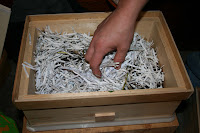

As more people become interested in composting there are more questions to be answered. We have already addressed the issue of what the difference between worms is, so now it's time to address the difference between composting methods.
The most common and well known form of composting is what is referred to as aerobic composting. That is the method of taking nitrogen rich organic matter such as food scraps and plant waste which is commonly called the "greens" and layering it with larger quantities of carbon matter such as shredded paper, or dry leaves called "browns". After layering these parts they are kept moist and occasionally aerated, that is, they are fluffed-up to allow more oxygen to reach the center of the pile which microorganisms use to survive and feed on the decaying matter, this also creates a great deal of heat so much heat that on a relatively warm day I have "turned" our compost pile and seen steam escaping.
As we have been out spreading the gospel of Vermicomposting we are very often asked the question, "can I just throw the worms in my outdoor compost pile?" Much like the answer about finding worms in you back yard, the answer is "yes" and "no". "Yes" but only under certain circumstances. "No" because outdoor aerobic composting is not optimal for worm life. Although it is usually dark inside the pile and there is usually the right amount of moisture and plenty of food, it will likely become far too hot for a red worms liking. If you regularly see worms of any kind in your compost then it will probably be fine to put red worms in there but you may want to invest in a compost thermometer to monitor the temperature and if you add worms you don't need to turn the pile as that may raise the heat level. Putting worms in outdoor compost containers such as tumblers or the tall black plastic towers is a bad idea, worms won't mind the occasional tumbling but those containers are designed to increase heat (they're usually dark colored or black) and nurture aerobic activity. If you're looking to make red worm fricassee this will probably work but unless you want to waste the $25+ dollars per pound spent on red worms I'd keep them in a worm bin in the shade.
Aerobic composting is capable of handling a larger quantity of waste since it is outdoors and less restricted by the appetites of worms but it takes about three times longer to break down and during the winter months may stop all together. However, a worm bin can be moved indoors to handle at least some of your scrap waste during the cold months and then gives you a finished fertilizer to use in early spring while the outdoor pile warms up and finishes breaking down. Especially as Spring approaches we will try and continue shelling out the useful information with regards to Vermicomposting so that you are ready to handle what nature throws at you.
No comments:
Post a Comment